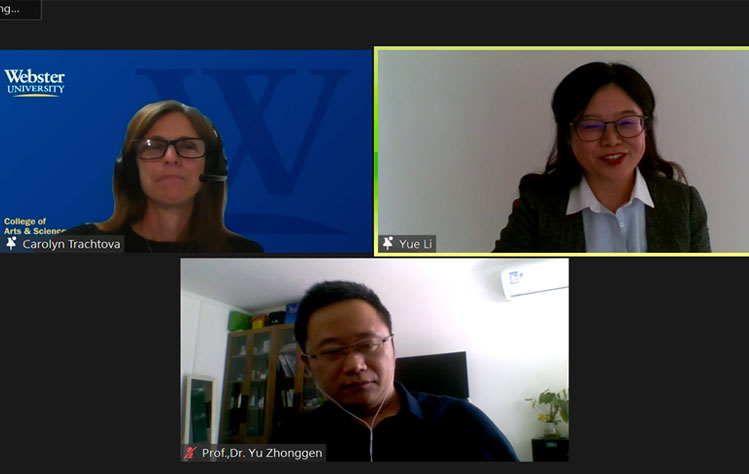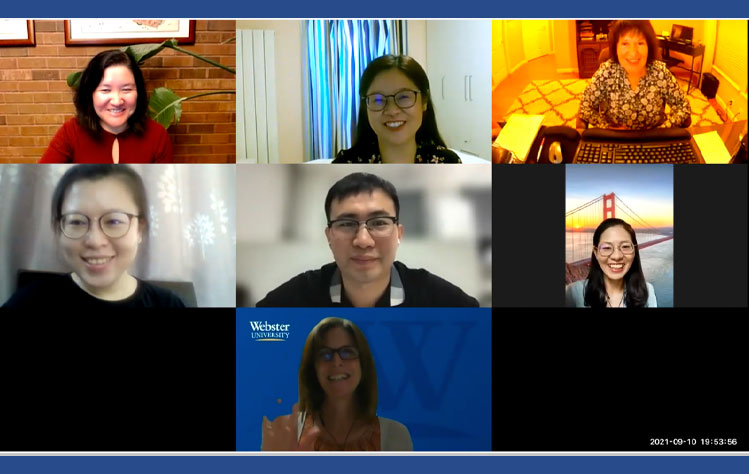Webster University Language Acquisition Lecture Series
September 30, 2021
In today’s world, language instructors need to be experts in all aspects of language teaching, from methodology and techniques to cross-cultural communication. In the months of May and September 2021, the Webster University ESL program and Confucius Institute partnered with Beijing Language and Culture University (BLCU) to host a series of four lectures on several aspects of language instruction. This lecture series reached hundreds of aspiring foreign language teachers looking for effective concepts and techniques to incorporate into their own practice. This series took place late on Friday evenings Central Time, meaning that students at BLCU and across Asia could also participate on their Saturday mornings. Each lecture featured one professor from Webster and one from BLCU. Below are some highlights for each lecture.

Session 1
Drawing over 90 participants from around the world, this first session on May 7 featured Webster University’s Carolyn Trachtova, ESL program director, and BLCU’s Professor Zhonggen Yu of the Department of Foreign Languages.
Trachtova delivered the presentation “Lighting a Spark: Increasing Student Motivation through Use of Content and Task-Based Course Design,”in which she showed in great detail how the Webster ESL program uses Content Based Instruction (CBI) and Task-Based Teaching/Learning (TBL) teaching strategies. Trachtova opened with an anecdote about a lesson she prepared early in her career that went wrong. She had expected her lesson on fairy tales to be well-received by her Czech undergraduate science students, and was surprised by their disinterest. This was when she first encountered CBI, which focuses on using authentic activities and organizes curricula and lessons through meaningful content or subject matter, rather than the more traditional focus on grammar or skills. She had much more success the next class, when she had students recreate summaries of a biology article, something directly relevant to their future careers. After explaining in detail how CBI looks at Webster University and reflecting on its benefits and drawbacks, she introduced TBI, where the focus of the lesson is on an overarching task that needs to be completed in the target language. Noting that blending CBI and TBL can be highly motivating and meaningful for students, she shared a task she has her students do during “Culture Week,” just after the end of the semester. Where students create a tourism blog for St. Louis that eventually gets used by future international students.
Following Trachtova’s presentation, Professor Yu delivered a synopsis of his paper, “Schema Theory-Based Flipped Classroom Model Assisted with Technology.” He started by explaining the concept of the flipped classroom, where students preview content at a deep level before class and spend the class time doing activities to practice and delve deeper into a topic. In doing this, these classes are often “assisted with technology” (FCAT) to help students learn. He emphasized the impact of social media and learning platforms to this end. Yu's research, which looked at over 70 studies of FCAT techniques, revealed a variety of shortcomings of traditional classrooms that FCAT helps to remedy. In this analysis, he referred to schema, or the concepts systematically developed in the brain through learning, as a way of examining the impacts of FCAT. Yu noted that the flipped classroom approach does have some challenges, such as its newness, which older teachers might not feel comfortable adapting to, and the resources required to implement it well.
Session 2
Adelia Chace of Webster University’s ESL program and Professor Chong Zhang of BLCU’s College of Information Science spoke May 14 on a topic that has become central to education in recent times — technology.
In a talk called Language, Learning and Technology, Chace noted that with the emergence of COVID-19, a wealth of online learning tools aided teachers immensely in the transition to online classes, but also left many feeling overwhelmed. Teachers were thrown necessarily into the world of educational technologies, new and old, trying to figure out which best suited their classes and kept students engaged. Having taught ESL online throughout the school year, she was able to make some sound recommendations to aspiring language teachers. Some, like Kahoot or Ted Talks, have widespread name recognition, while others, like a polling website called Mentimeter, less so. In her reviews, Chace focused on specific benefits each technology brought to the lesson. For example, Mentimeter allows for real-time feedback and elicits participation from even the most quiet or hesitant of students in a fun way.
Following this, Professor Zhang gave a presentation titled The Application of Information Technology in Chinese International Education. Professor Zhang, like Chace, noted the worldwide impact of COVID-19 as she shared her first research question: Has the worldwide demand for Chinese language learning increased or decreased? She shared her research monitoring Chinese International Education web search data, which concluded that the enthusiasm for studying Chinese has increased, even as the actual numbers of students studying in China has decreased, as one might expect during a pandemic. She then asked a second question: How can teachers improve upon the effectiveness and efficiency of teaching Chinese virtually? She shared fascinating tools developed by her colleagues such as technologies that automatically evaluate Chinese character writing and pronunciation, as well as those that aid in reading Chinese-language articles. Unique among this series’ panelists in that she is not a language teacher, Professor Zhang’s presentation brought some truly insightful, even groundbreaking information and technology to the attention of the many Chinese language teachers in attendance.

Session 3
Adjunct faculty member Mercedes Stephenson of Webster University’s Global Languages, Cultures and Societies Department and Jie He of BLCU’s Department of Foreign Languages each delivered highly informative talks, drawing an audience of 122 guests.
Stephenson's talk, “Methodological Approaches to Teaching Chinese as a Second Language,” examined the methodology, approach, method, curriculum and technique of foreign language instruction. She advocated for a style of teaching known as Communicative Language Teaching, which emphasizes learner-centered instruction and a focus on real-world, functional tasks. To make these concepts tangible, Stephenson discussed how she implements them in her own language classroom. Functional tasks might include a yoga class taught in the target language, so that students actually need to listen and move their body accordingly, while asking students to make and share lists — such as “things that make me smile” — integrates writing with student-to-student communication.
Following Stephenson’s talk, Professor He delivered “Creating an Interactive Classroom,” talking through a number of quality lesson activities that facilitate student-to-student and teacher-to-student communication, as well as activities making use of visual media. On such activity is called “Think-Pair-Share,” which gives students an opportunity to find the words for a response, use them to first communicate with a fellow students, and finally share their thoughts with the whole class. Some attendees, excited by some of Professor He’s activity suggestions, even asked in the chat if she had taken videos of her classes so that they might see how to best facilitate them.
 Session 4
Session 4
This final evening featured adjunct faculty member Diana Pascoe of Webster University’s Global Languages, Cultures and Societies Department on Sept. 17. The talk and subsequent question and answer session was hosted by Professor Lihong Wang of BLCU.
Drawing on her own fascinating life story in addition to academic theories, Pascoe’s talk was titled “Teaching Culture and Intercultural Communication.” Born in Mexico and having grown up in Venezuela before moving with her parents to the United States, Pascoe gave contextualized, first-hand accounts illustrating principles of intercultural communication of which teachers ought to be aware. In talking of the “Cultural Iceberg,” a framework illustrating the observable and not observable aspects of culture, she discussed her own experience of an American friend pointing out to her that she never made eye contact during their conversations. Though normal in Venezuela, the friend had to specifically explain that Americans value eye contact and draw certain culturally-based conclusions about those who avoid it. Moving on to Hofstede’s Cultural Dimensions model, she showed how researchers have attempted to quantify aspects of culture such as individuality, and used car advertisements from both the United States and Venezuela to humorously demonstrate the difference in how this trait is valued in the two countries. After laying a theoretical framework, Pascoe moved on to applications, giving clear examples of how she integrated culture into her classes. She emphasized analytical skills, noting that media or even food can be the subject of serious academic study.
Professor Wang then discussed her own research interest, which focuses on the phenomenon of Chinese postgraduate students studying abroad and depicts their learning trajectory as they adjust to a new culture of teaching and learning in a new environment. Professor Wang took thought-provoking questions from the audience and also engaged Pascoe in a stimulating conversation.
Series Summary
Taken as a whole, this series offered up a broad range of theories, technologies and practical suggestions for the aspiring language teachers. Each speaker’s depth of knowledge in their specialized domain led to evenings both enjoyable and jam-packed with valuable information. Given its success and the sound relationships forged between Webster University and BLCU faculty and staff along the way, it is likely to be the first of many future collaborations of this nature.
